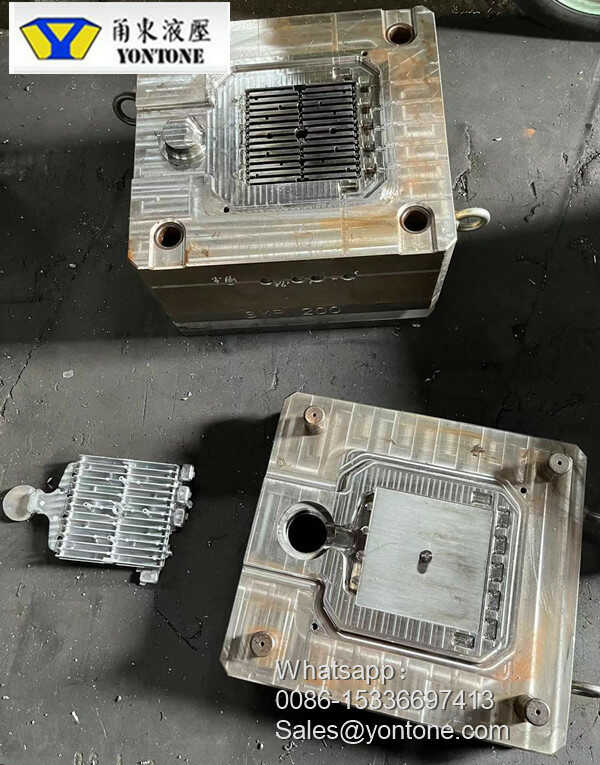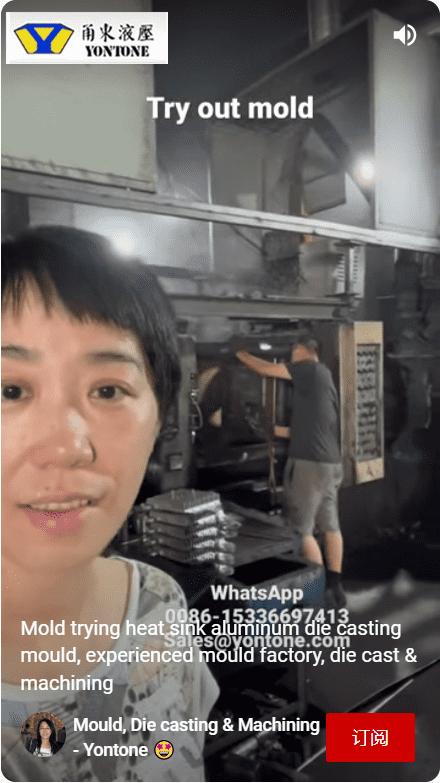Our daily work is producing high-quality die castings and die casting molds.
Today we are making Aluminum Die Casting Heatsinks.

We can take a close look at the design and structure of this aluminum die casting mold. For better heat dissipation, we deliberately increased the height of the radiator (heat sink fins). Click on the picture and you can see a video of the mold.

No matter how many different radiators there are today, aluminum alloy die-casting heatsink & radiators and aluminum extrusion radiators are the most commonly used ones. Today we are going to show you the production process of our company’s aluminum alloy die-casting heat sink radiators for LED street lights. You can click on the picture to see the video.
1. Why do LED street light housings need to be designed with heat sink dissipation?
At present, the biggest technical problem of LED lighting fixtures is the problem of heat dissipation. The poor heat dissipation leads to the LED driving power supply and electrolytic capacitors, which have become the shortcomings of the further development of LED lighting fixtures, and the reason for the premature aging of LED light sources. At present, after the LED light source is powered on, about 30% of the electrical energy is converted into light energy, and the rest is converted into thermal energy.
Therefore, it is the key technology of LED lamp structure design to export so much heat energy as soon as possible. The heat energy needs to be dissipated through heat conduction, heat convection, and heat radiation. Only by exporting heat as soon as possible can the cavity temperature in the LED lamp be effectively reduced, the power supply can be protected from working in a long-lasting high-temperature environment, and the premature aging of the LED light source due to long-term high-temperature operation can be avoided.
2. The heat dissipation path of LED street lights.
Because the LED light source itself has no infrared and ultraviolet rays, and the LED light source itself has no radiation heat dissipation function, the heat dissipation path of the LED lighting fixture can only be used to dissipate heat through the radiator closely combined with the LED lamp bead board. The radiator must have the functions of heat conduction, heat convection, and heat radiation.
Any radiator, in addition to being able to quickly conduct heat from the heat source to the surface of the radiator, mainly relies on convection and radiation to dissipate heat into the air. Heat conduction only solves the way of heat transfer, while heat convection is the main function of the radiator. The heat dissipation performance is mainly determined by the heat dissipation area, shape, and the ability of natural convection strength, and heat radiation is only an auxiliary role.
Generally speaking, if the distance from the heat source to the surface of the heat sink is less than 5mm, then as long as the thermal conductivity of the material is greater than 5, the heat can be dissipated, and the rest of the heat dissipation must be dominated by thermal convection.
3. Possible problems in heat sink thermal design.
a. The area of the cooling fins can be arbitrarily set.
b. The arrangement of the heat dissipation fins is unreasonable. The arrangement of the heat dissipation fins of the lamps does not consider the use of the lamps, which affects the performance of the fins.
4. How to use heat sink to dissipate heat from LED street lights.
At present, the heat dissipation methods of LED street lamps mainly include: natural convection heat dissipation, forced heat dissipation by installing fans, heat pipe and loop heat pipe heat dissipation, etc. The system is complicated and the reliability is low, and the heat dissipation method of heat pipe and loop heat pipe is expensive. The street lamp has the advantages of outdoor nighttime use, the heat dissipation surface is located on the side, and the body size is less restricted, which is conducive to natural convection heat dissipation of the air. Therefore, it is recommended to choose the natural convection heat dissipation method as much as possible for LED street lamps.
5. The way the heat sink is formed.
Most LED lighting sources still use low-voltage (VF=3.2V), high-current (IF=200-700mA) LED lamp beads. Due to the high heat during operation, aluminum alloys with high thermal conductivity must be used. Usually there are die-cast aluminum radiators, extruded aluminum radiators, and stamped aluminum radiators.
a. Die casting heat sink (radiator)
Die-casting aluminum radiator is a technology of die-casting parts. Liquid zinc-copper-aluminum alloy is poured into the feed port of the die-casting machine and then die-casted by the die-casting machine to cast the shape radiator defined by the pre-designed mold.
The production cost is controllable, and the heat dissipation fins cannot be made thin, making it difficult to maximize the heat dissipation area. The commonly used die-casting materials for LED lamp heat sinks are ADC10 and ADC12.
b. Extruded aluminum heat sink (radiator)
The liquid aluminum is extruded through a fixed die, and then the bar is machined and cut into a radiator of the required shape, and the post-processing cost is relatively high. The cooling fins can be made very thin, and the heat dissipation area is expanded to the greatest extent. When the cooling fins work, air convection is automatically formed to diffuse heat, and the heat dissipation effect is better. Commonly used materials are AL6061 and AL6063.
c. Stamped aluminum radiator
It is to punch and lift the steel and aluminum alloy plates by punching machines and molds to make them into cup-shaped radiators. The inner and outer periphery of the stamped radiators are smooth, and the heat dissipation area is limited due to the lack of wings. Commonly used aluminum alloy materials are 5052, 6061, and 6063. The quality of stamping parts is small and the material utilization rate is high, which is a low-cost solution. The heat conduction of the aluminum alloy radiator is ideal, and it is more suitable for the isolated switching constant current power supply. For non-isolated switching constant-current power supplies, it is necessary to isolate AC and DC, high-voltage and low-voltage power supplies through the structural design of the lamps to pass CE or UL certification.
d. Plastic-coated aluminum radiator
It is a heat-conducting plastic shell aluminum core radiator. The thermally conductive plastic and the aluminum heat dissipation core are formed on the injection molding machine at one time, and the aluminum heat dissipation core is used as an embedded part and needs to be machined in advance. The heat of the LED lamp bead is quickly transferred to the thermally conductive plastic through the aluminum heat dissipation core, and the thermally conductive plastic uses its multi-wings to form air convection heat dissipation and uses its surface to radiate part of the heat.
The plastic-coated aluminum radiator generally uses the original colors of thermally conductive plastics, white and black, and the black plastic-coated aluminum radiator has a better radiation heat dissipation effect. Thermally conductive plastic is a thermoplastic material. The fluidity, density, toughness, and strength of the material are easy for injection molding. It has good resistance to cold and thermal shock cycles and excellent insulation properties. The emissivity of thermally conductive plastics is better than that of ordinary metal materials.
The density of thermally conductive plastic is 40% smaller than that of die-casting aluminum and ceramics, and the weight of plastic-coated aluminum can be reduced by nearly one-third for the same shape of radiator; compared with all-aluminum radiators, the processing cost is low, the processing cycle is short, and the processing temperature is low; The finished product is not easy to break; the customer-owned injection molding machine can carry out the differentiated shape design and production of lamps. The plastic-clad aluminum radiator has good insulation performance and is easy to pass safety regulations.
e. High thermal conductivity plastic heat sink
High thermal conductivity plastic radiator has developed rapidly recently. High thermal conductivity plastic radiator is an all-plastic radiator. Its thermal conductivity is dozens of times higher than ordinary plastics, reaching 2-9w/mk. It has excellent heat conduction and heat radiation capabilities. ; A new type of insulation and heat dissipation material that can be used in various power lamps, and can be widely used in various types of LED lamps from 1W to 200W.
High thermal conductivity plastic can withstand voltage up to 6000V AC, suitable for high voltage linear constant current power supply using non-isolated switching constant current power supply and HVLED. Make this type of LED lighting easy to pass CE, TUV, UL, and other strict safety inspections. HVLED adopts a high voltage (VF=35-280VDC) and low current (IF=20-60mA) working state, so the heat generation of the HVLED lamp bead board is reduced. The high thermal conductivity plastic radiator can use traditional injection molding or extruding machine.
Once formed, the finished product has a high finish. The productivity is greatly improved, and the design flexibility is high, which can give full play to the designer’s design concept. High thermal conductivity plastic radiator is made of PLA (corn starch) polymerization, fully degradable, no residue, no chemical pollution, no heavy metal pollution, no sewage, no waste gas in the production process, in line with global environmental protection requirements.
The PLA molecules inside the high thermal conductivity plastic heat sink are densely distributed with nano-scale metal ions, which can move rapidly at high temperatures and increase thermal radiation energy. Its vitality is better than that of metal heat sinks. High thermal conductivity plastic heat sink can withstand high temperatures, 150 ℃ for five hours without cracking or deformation, with the application of high-voltage linear constant current IC driver solution, no need for electrolytic capacitors and bulk inductance, greatly improving the life of the entire LED lamp, non-isolated power supply solution, high efficiency, low cost. Especially suitable for the application of fluorescent tubes and high-power industrial and mining lamps.
The high thermal conductivity plastic radiator can be designed with many precise cooling fins. The cooling fins can be made very thin, and the heat dissipation area can be expanded to the maximum. When the cooling fins work, air convection is automatically formed to diffuse heat, and the heat dissipation effect is better. The heat of the LED lamp bead goes directly to the heat dissipation fins through the high thermal conductivity plastic and dissipates quickly through air convection and surface radiation.
High thermal conductivity plastic heat sinks are lighter in density than aluminum. The density of aluminum is 2700kg/m3, while the density of plastic is 1420kg/m3, which is almost half of that of aluminum, so the weight of a plastic radiator of the same shape is only 1/2 of that of aluminum. Moreover, the processing is simple, and the molding cycle can be shortened by 20-50%, which also reduces the power of cost.
————————————————————————————————-
The professional manufacturing and service team can fully meet the high-quality and high-efficiency needs of customers and can continue to provide our best services.
Welcome to contact us.
Ningbo Beilun Yontone Hydraulic Technology Co., Ltd.
WhatsApp: +86 15336697413
Email: sales@yontone.com
Mold, molddesign, moldmaking, mould, mouldmaking, molding, moulding, moldmaker, mouldmaker, engineeringsolutions, Casting, Diecasting, foundry, cncmachining, metalmachining, Metalprocessing, manufacturing, supplier, manufacturer, factory


